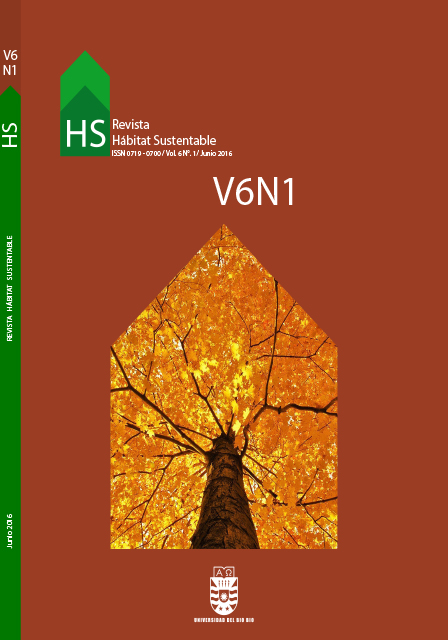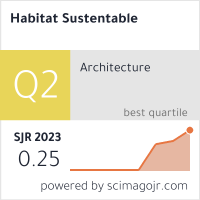Ahorros en los consumos para enfriamiento de espacios interiores mediante la evaluación de sistemas de protección solar en edificios residenciales en altura. El caso de la "ciudad-oasis" de Mendoza, Argentina
DOI:
https://doi.org/10.22320/07190700.2016.06.01.08Palabras clave:
arquitectura ambiental, protección, ahorro, protección, edificios en alturaResumen
El presente trabajo estudia el comportamiento térmico y energético de edificios residenciales en altura, en el contexto particular de una “ciudad-oasis”. Se plantea como objetivo la definición de sistemas de control solar adecuados en la envolvente para cada tipología material de edificio -másica y liviana- y para cada estrato en altura de las viviendas: debajo y sobre de la copa de los árboles. El monitoreo de viviendas en uso permite validar modelos geométricos (software Energy Plus) y simular propuestas de aplicación de elementos de protección solar. Se analizan los ahorros en los consumos para enfriamiento en departamentos en niveles bajos, medios y altos. Los resultados muestran que en el edificio másico, en las viviendas ubicadas debajo de la copa de los árboles, es posible anular las cargas energéticas para enfriamiento mediante el uso de elementos exteriores de protección solar. Mientras que en las viviendas sobre la copa de los árboles, los ahorros energéticos se encuentran entre el 32% y 42%. En el edificio liviano, la aplicación de sistemas de control en departamentos bajo la copa de los árboles alcanza ahorros del orden del 53% y en las viviendas sobre la copa, las reducciones energéticas se encuentran entre el 46% y 54%. Las dimensiones adecuadas de tales elementos pueden generar propuestas posibles de ser transferidas a las normativas locales de edificación.
Descargas
Citas
BALTER, Julieta. Sustentabilidad de edificios en altura en Ciudades-Oasis. Características arquitectónicas y ambientales para el caso de la ciudad de Mendoza. Tesis doctoral. Facultad de Arquitectura y Urbanismo. Universidad Nacional de La Plata. La Plata, Argentina, 2015.
BALTER, Julieta, GANEM, Carolina, DISCOLI, Carlos. On high-rise residential buildings in an oasis-city: Thermal and energy assessment of different envelope materiality above and below tree canopy. Energy and Buildings, 2016, n° 113, pp. 61-73.
BAKER, Nick y FANCHIOTTI, Aldo. Daylighting in Architecture: A European Reference Book. Commission of the European Communities. London, UK: James & James Ltd., 1993.
BÓRMIDA, Eliana. Mendoza, una ciudad oasis. Mendoza, Argentina: Universidad de Mendoza, 1984.
CANTÓN, Alicia, MESA, Alejandro, CORTEGOSO, José Luis y DE ROSA, Carlos. Assessing the solar resource in forested urban environments: results from the use of a photographic-computational method. Architectural Science Review, 2003, n° 46, pp. 115–123.
CHO, Jinkyun, YOO, Changwoo y KIM, Yundeok. Viability of exterior shading devices for high-rise residential buildings: Case study for cooling energy saving and economic feasibility analysis. Energy and Buildings, 2014, n° 82, pp. 771-785.
CZAJKOWSKI, Jorge y CORREDERA, Cecilia. Ahorro de Energía en Refrigeración de Edificios Para Viviendas y Propuesta de Indicadores de Eficiencia y Valores Admisibles. Avances en Energías Renovables y Medio Ambiente, 2006, n° 10, pp. 09-16.
ENERGY PLUS. The official building simulation program of the United States Department of Energy. [Consultado 16 de Junio de 2013]. Disponible en: http://apps1.eere.energy.gov/buildings/energyplus/
EPRE MENDOZA. Informe demanda Mendoza y Cuyo: 2013 [en línea]. [Consultado 9 de Febrero de 2016]. Disponible en: http://www.epremendoza.gov.ar/_a_adjuntos/Inf_Demanda_Cuyo_ANUAL_2013.pdf
ESTEVES, Alfredo, GELARDI, Daniel. Docencia en Arquitectura Sustentable: Programa de Optimización de Proyectos de Arquitectura basado en el balance térmico. Avances en Energías Renovables y Medioambiente, 2003, n° 7, pp. 31-34.
FLORES LARSEN, Silvana. Simulación térmica de un edifico de oficinas con doble fachada vidriada en la Ciudad de Salta, Avances en Energías Renovables y Medio Ambiente, 2010, n° 14, pp. 73-80.
FILIPPÍN, Celina y FLORES LARSEN, Silvana. Comportamiento térmico de verano de viviendas unifamiliares compactas en condiciones reales de uso en clima templado en Argentina. Avances en Energías Renovables y Medio Ambiente, 2010, n° 14, p. 1-8, 2010.
GIVONI, Baruch. Comfort, climate analysis and building design guidelines. Energy and Building, 1992, vol. 18, n° 1, pp 11-23. GRATIA, Elisabeth y DE HERDE, André. The most ef cient position of shading devices in a double skin façade. Energy and Buildings, 2007, vol. 39, n° 3, pp. 364–373.
IRAM (Instituto Argentino de Normalización). Norma IRAM 11605. Acondicionamiento térmico de edi cios. Condiciones de habitabilidad en edi cios. Valores máximos admisibles de transmitancia térmica en cerramientos opacos, 1996.
JUODIS, E, JARAMINIENE, E y DUDKIEWICZ, E. Inherent variability of heat consumption in residential buildings. Energy and Buildings, 2009, vol. 41, pp. 1188-1194.
LONGOBARDI, M. y HANCOCK, M. Field Trip Strategies. TIA 2000 Conference Proceedings. Oxford: Oxford Brookes University, 2000.
MUNICIPALIDAD DE MENDOZA. Código de Edificación, 2002, Ordenanza N◦3296/14975/1996.
OLDFIELD, Philip, TRABUCCO, Dario y WOOD, Antony. Five energy generations of tall buildings: an historical analysis of energy consumption in high-rise buildings. The Journal of Architecture, 2009, n° 14, pp. 591–610.
OLGYAY, Víctor. Arquitectura y Clima. Manual de diseño bioclimático para arquitectos y urbanistas. Barcelona, España: Editorial Gustavo Gili, 1998.
PALMERO-MARRERO, Ana y OLIVEIRA, Armando. Effect of louver shading devices on building energy requirements. Applied Energy, 2010, vol. 87, n° 6, pp. 2040-2049.
TOFTUM, J, ANDERSEN, R y JENSEN, K. Occupant performance and building energy consumption with different philosophies of determining acceptable thermal conditions. Building Environment, 2009, vol. 44, pp. 2009–2016.
Descargas
Publicado
Cómo citar
Número
Sección
Licencia
Derechos de autor 2016 Hábitat Sustentable

Esta obra está bajo una licencia internacional Creative Commons Atribución-CompartirIgual 4.0.
El contenido de los artículos que se publican en cada número de Hábitat Sustentable, es responsabilidad exclusiva de los autores y no representan necesariamente el pensamiento ni comprometen la opinión de la Universidad del Bío-Bío.
Los autores/as conservarán sus derechos de autor y garantizarán a la revista el derecho de primera publicación de su obra, el cuál estará simultáneamente sujeto a la Licencia de Reconocimiento de Creative Commons CC BY-SA que permite a otros compartir-copiar, transformar o crear nuevo material a partir de esta obra con fines no comerciales, siempre y cuando se reconozcan la autoría y la primera publicación en esta revista, y sus nuevas creaciones estén bajo una licencia con los mismos términos.











 Programa de Información Científica/Concurso Fondos de Publicación de Revistas Científicas 2018/ Proyecto Mejoramiento de Visibilidad de Revistas UBB (Código:FP180007)
Programa de Información Científica/Concurso Fondos de Publicación de Revistas Científicas 2018/ Proyecto Mejoramiento de Visibilidad de Revistas UBB (Código:FP180007) 





